The plan to dump treated radioactive waste water from a nuclear plant into the sea has stirred debates in South Korea, and led to boycotts of Japanese goods in China
Japanese fishermen, whose livelihoods could be severely impacted, have also vehemently opposed the waste water disposal plan
Amy Sood
SCMP
29 Jun, 2023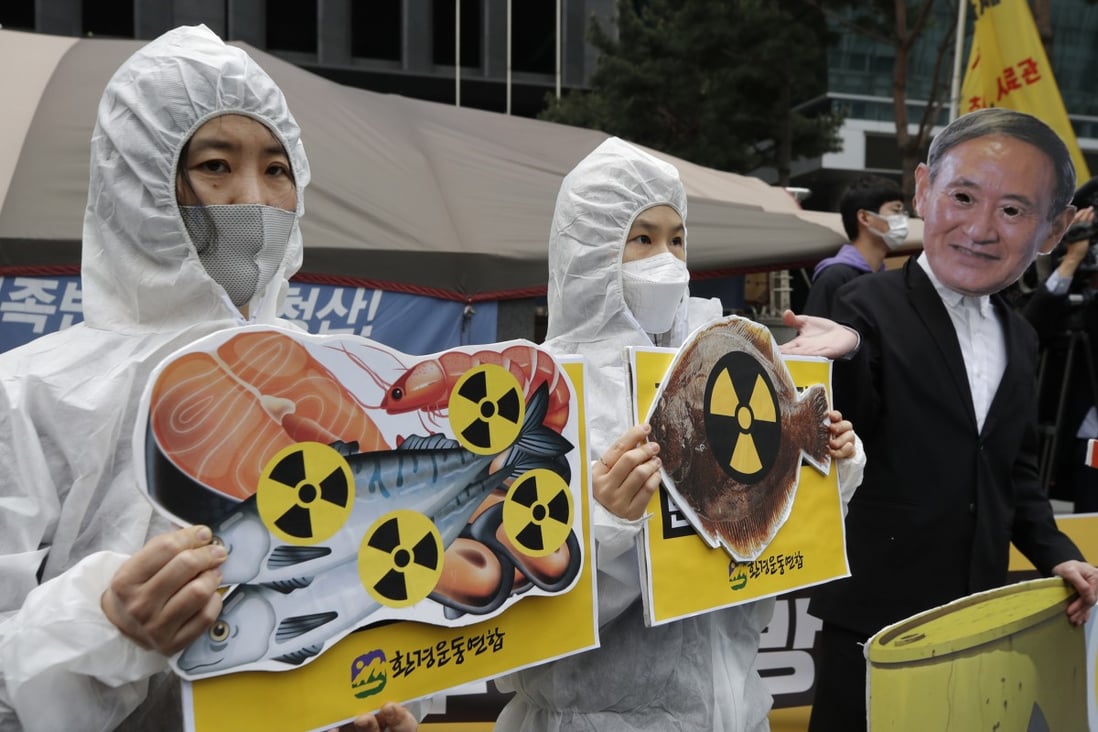
Environmental activists denounce the Japanese government’s plan to start releasing treated radioactive water from the wrecked Fukushima nuclear plant into the Pacific Ocean. Photo: AP
As Japan prepares to release treated radioactive waste water from the wrecked Fukushima nuclear plant into the sea, opposition to the controversial plan continues to simmer across the region.
The country’s nuclear regulator on Wednesday began a final inspection of the water which is currently stored in about 1,000 huge tanks. It will be filtered and diluted before being released through an underwater tunnel that stretches one kilometre into the ocean.
But while Tokyo has sought to do its due diligence – seeking approval from its domestic nuclear regulator and ensuring the water meets international safety standards – the venture continues to spark controversy.
A Greenpeace statement expressed concerns that the released radioactivity could alter human DNA, and Pacific Island nations have stated their worries that the move could contribute to nuclear contamination of the Blue Pacific.
The matter has also stirred debates in South Korea, and led to a consumer boycott of Japanese cosmetics in China.
Why the worry over Japan’s nuclear waste plan? France has done it ‘for decades’
21 Mar 2023
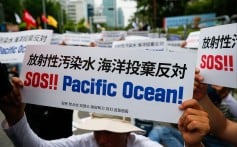
“The Fukushima water discharge is not a unique event or without precedent, because nuclear power plants worldwide have been routinely discharging water containing tritium for over 60 years without harm to people or the environment.
“And in most of these cases, there is tritium at higher levels than what is planned with Fukushima,” he added.
Experts believe the real danger could be the continued storage of contaminated water in the event of a spill from another natural disaster or human error.
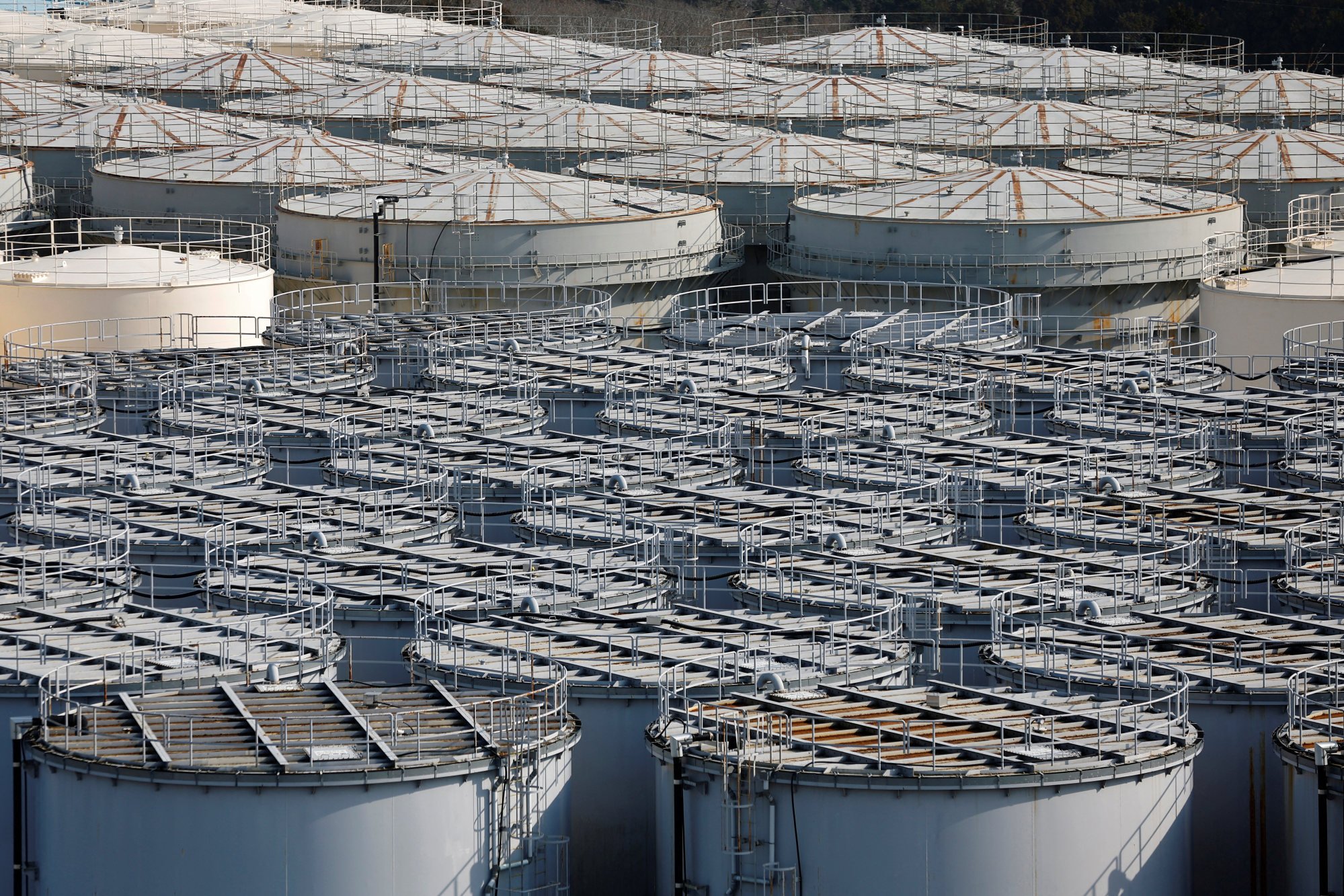
Tanks containing water from the disabled Fukushima Dai-ichi nuclear power plant. Photo: Reuters
Fishing communities
However, there are still concerns that certain dangerous radionuclides – like cobalt and strontium – might slip through the filtering and water treatment process. Many scientists and environmentalists have also said there is a lack of knowledge about the long-term effects of exposure to even low doses of tritium.
To this point – Irwin asserted that the independent inspection by the IAEA provides confidence that only water with safe levels of tritium will be discharged.
“Samples of the water were tested by Tepco and seven other independent labs [globally], and the results showed a high level of agreement that there was no additional radioactive nuclides at significant levels at all,” he said.
Japan must also continually monitor the water quality once it has been discharged into the sea, and invite independent bodies and scientists to do so too, experts added.
But Japanese fishermen – whose livelihoods could be severely impacted – have vehemently opposed the waste water disposal plan.
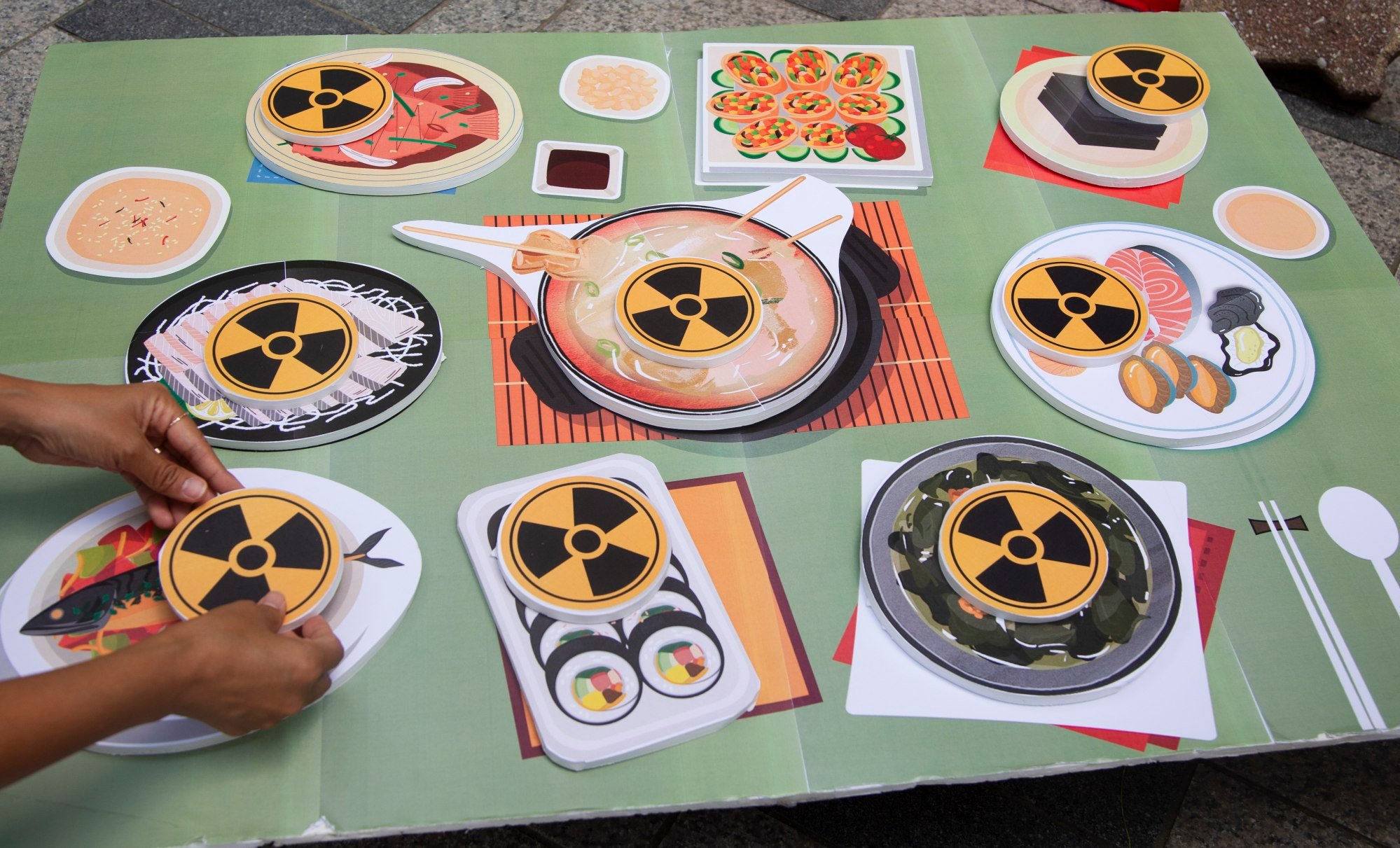
A member of an environmental group places signs symbolising the Fukushima nuclear disaster during a rally against Japan’s disposal of radioactive water, outside the Japanese embassy in Seoul, South Korea. Photo: EPA-EFE
The industry’s reputation suffered greatly following the 2011 nuclear disaster, when dozens of countries banned imports of produce from Fukushima and other nearby prefectures. The United States and the European Union only eased their restrictions in 2021.
“We cannot support the government’s stance that an ocean release is the only solution,” said Masanobu Sakamoto, president of JF Zengyoren, or the National Federation of Fisheries Cooperatives, according to the Associated Press.
“Whether to release the water into the sea or not is a government decision, and in that case we want the government to fully take responsibility,” he added.
Tokyo has said that it will set up a fund to promote Fukushima seafood and provide compensation to fishermen in case sales fall due to safety concerns.
South Korean lawmaker challenges Japan officials to drink Fukushima water
16 May 2023

Diplomatic dilemmas
The issue has become a hot topic in the parliament of South Korea, Japan’s neighbour separated only by a body of water.
The country’s main opposition, the Democratic Party of Korea (DPK) is seeking collective action with Pacific nations against the Japanese plan, but the government is seeking a more diplomatic approach – urging the public and the opposition to await the results of safety reviews.
The political divide comes as no surprise as South Korean President Yoon Suk-yeol has been trying to mend the country’s historically troubled relationship with Japan to deepen military ties.
In May, a 21-member South Korean delegation was welcomed by Japanese Prime Minister Fumio Kishida to visit the Fukushima plant to examine safety concerns.
Like in Japan, members of the ruling party are also making efforts to alleviate public concerns about produce safety in South Korea, visiting seafood markets and vowing to support businesses who fear a drop in sales.
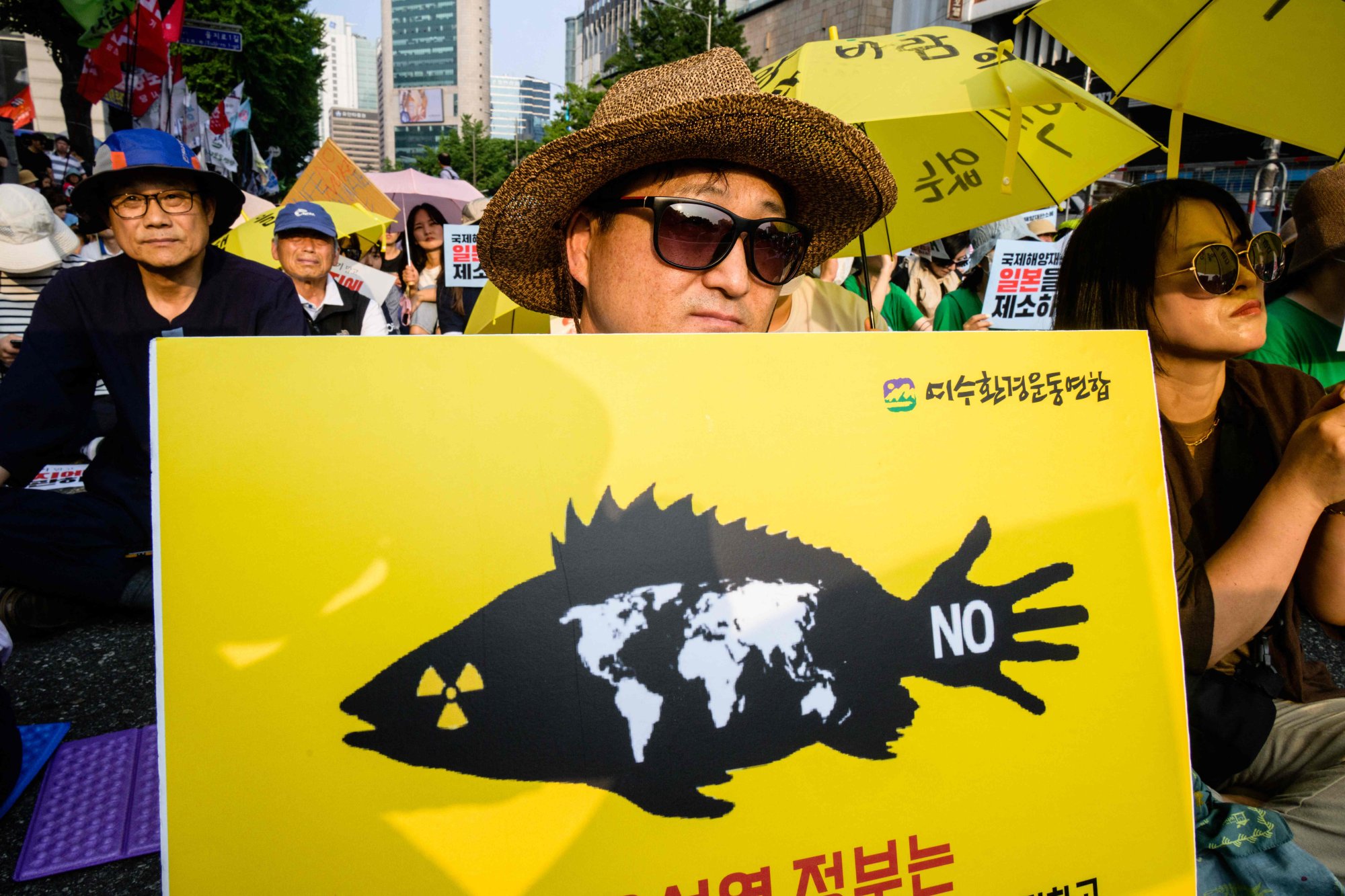
Activists gather in Seoul to protest against a planned release of water from the Fukushima Dai-Ichi nuclear plant. Photo: AFP
Opposition lawmakers, however, maintain that the ruling party is prioritising diplomatic relations over public safety.
In China, viral social media campaigns are spreading on Weibo and Chinese lifestyle platform Xiaohongshu, with users listing Japanese brands and questioning their safety.
Major Japanese cosmetic company Shiseido saw its largest weekly stock plunge in nearly 10 months, and a 6.8 per cent drop in its shares, according to Bloomberg.
But some observers suggest this might be a short-lived phenomenon.
“I don’t think there will be a huge material impact in the long-term,” said Jeanie Chen, a senior equity analyst at Morningstar in Japan.
The outcry on social media might have some immediate impact on the sales of Japanese goods, but unless the Chinese government makes a strong line or bans the products, it will not be substantial, she added.
Additional reporting by the Associated Press
29 Jun, 2023

Environmental activists denounce the Japanese government’s plan to start releasing treated radioactive water from the wrecked Fukushima nuclear plant into the Pacific Ocean. Photo: AP
As Japan prepares to release treated radioactive waste water from the wrecked Fukushima nuclear plant into the sea, opposition to the controversial plan continues to simmer across the region.
The country’s nuclear regulator on Wednesday began a final inspection of the water which is currently stored in about 1,000 huge tanks. It will be filtered and diluted before being released through an underwater tunnel that stretches one kilometre into the ocean.
But while Tokyo has sought to do its due diligence – seeking approval from its domestic nuclear regulator and ensuring the water meets international safety standards – the venture continues to spark controversy.
A Greenpeace statement expressed concerns that the released radioactivity could alter human DNA, and Pacific Island nations have stated their worries that the move could contribute to nuclear contamination of the Blue Pacific.
The matter has also stirred debates in South Korea, and led to a consumer boycott of Japanese cosmetics in China.
Why the worry over Japan’s nuclear waste plan? France has done it ‘for decades’
21 Mar 2023
In Hong Kong, Secretary for Environment and Ecology Tse Chin-wan said on Wednesday that if the discharge went ahead as planned, the city would immediately prohibit the import of aquatic products from the coastal prefectures in proximity to Fukushima and impose “stringent import control” on other such goods from elsewhere in Japan.
Local fishing communities in Fukushima are still suffering from bans on their produce, and many oppose the plan fearing reputational damage bringing financial losses to their business.
But the Japanese government maintains the water is safe, and is hoping to get a green light from the International Atomic Energy Agency (IAEA), which is set to release its final report on the safety of the Fukushima plan soon.
The United Nations and nuclear experts in Japan have also said the treated waste water poses no threat.
The science
A massive earthquake and tsunami that hit the Japanese coast in 2011 melted down three reactors at the Fukushima plant and killed thousands of people.
Twelve years later, the damaged reactor cores still need to be cooled with water. But space to store this liquid is running out.
According to Associated Press, the tanks containing the treated water will reach their capacity in 2024. Last month, the storage tanks reached 97 per cent capacity, prompting Japan to move ahead with its plan to filter, treat and dilute the contaminated water before discharging it into the Pacific Ocean this summer.
Under the plan spearheaded by the nuclear plant’s operator, Tokyo Electric Power Company (Tepco), more than 1.3 million tons of water will be gradually released over two to three decades.
That proposal, as well as the safety of the treated water, has been questioned. Liu Guangyuan, the Commissioner of China’s Ministry of Foreign Affairs in Hong Kong has argued that if the water is truly safe, it should be released off the coast of Japan rather than building a seabed tunnel to discharge it into the ocean.
I think there is an understandable perception that all radioactive materials are dangerous, particularly radioactive and liquid waste, but this is not the caseTony Irwin, nuclear engineer
The water is being treated on-site to remove most of its radioactive materials, but will still contain trace levels of tritium – a radioactive form of hydrogen that is difficult to separate from water. Scientists say there is no viable technology to remove the negligible concentrations of tritium from this volume of water.
“I think there is an understandable perception that all radioactive materials are dangerous, particularly radioactive and liquid waste, but this is not the case,” said Tony Irwin, an honorary associate professor at the Australian National University’s nuclear physics department.
Irwin pointed out that Japan is meeting international standards for safe levels of tritium, and is in fact choosing a conservative limit to release over a fairly long stretch of time.
‘I would be willing’: South Korean PM offers to drink treated Fukushima water
14 Jun 2023
Local fishing communities in Fukushima are still suffering from bans on their produce, and many oppose the plan fearing reputational damage bringing financial losses to their business.
But the Japanese government maintains the water is safe, and is hoping to get a green light from the International Atomic Energy Agency (IAEA), which is set to release its final report on the safety of the Fukushima plan soon.
The United Nations and nuclear experts in Japan have also said the treated waste water poses no threat.
The science
A massive earthquake and tsunami that hit the Japanese coast in 2011 melted down three reactors at the Fukushima plant and killed thousands of people.
Twelve years later, the damaged reactor cores still need to be cooled with water. But space to store this liquid is running out.
According to Associated Press, the tanks containing the treated water will reach their capacity in 2024. Last month, the storage tanks reached 97 per cent capacity, prompting Japan to move ahead with its plan to filter, treat and dilute the contaminated water before discharging it into the Pacific Ocean this summer.
Under the plan spearheaded by the nuclear plant’s operator, Tokyo Electric Power Company (Tepco), more than 1.3 million tons of water will be gradually released over two to three decades.
That proposal, as well as the safety of the treated water, has been questioned. Liu Guangyuan, the Commissioner of China’s Ministry of Foreign Affairs in Hong Kong has argued that if the water is truly safe, it should be released off the coast of Japan rather than building a seabed tunnel to discharge it into the ocean.
I think there is an understandable perception that all radioactive materials are dangerous, particularly radioactive and liquid waste, but this is not the caseTony Irwin, nuclear engineer
The water is being treated on-site to remove most of its radioactive materials, but will still contain trace levels of tritium – a radioactive form of hydrogen that is difficult to separate from water. Scientists say there is no viable technology to remove the negligible concentrations of tritium from this volume of water.
“I think there is an understandable perception that all radioactive materials are dangerous, particularly radioactive and liquid waste, but this is not the case,” said Tony Irwin, an honorary associate professor at the Australian National University’s nuclear physics department.
Irwin pointed out that Japan is meeting international standards for safe levels of tritium, and is in fact choosing a conservative limit to release over a fairly long stretch of time.
‘I would be willing’: South Korean PM offers to drink treated Fukushima water
14 Jun 2023

“The Fukushima water discharge is not a unique event or without precedent, because nuclear power plants worldwide have been routinely discharging water containing tritium for over 60 years without harm to people or the environment.
“And in most of these cases, there is tritium at higher levels than what is planned with Fukushima,” he added.
Experts believe the real danger could be the continued storage of contaminated water in the event of a spill from another natural disaster or human error.

Tanks containing water from the disabled Fukushima Dai-ichi nuclear power plant. Photo: Reuters
Fishing communities
However, there are still concerns that certain dangerous radionuclides – like cobalt and strontium – might slip through the filtering and water treatment process. Many scientists and environmentalists have also said there is a lack of knowledge about the long-term effects of exposure to even low doses of tritium.
To this point – Irwin asserted that the independent inspection by the IAEA provides confidence that only water with safe levels of tritium will be discharged.
“Samples of the water were tested by Tepco and seven other independent labs [globally], and the results showed a high level of agreement that there was no additional radioactive nuclides at significant levels at all,” he said.
Japan must also continually monitor the water quality once it has been discharged into the sea, and invite independent bodies and scientists to do so too, experts added.
But Japanese fishermen – whose livelihoods could be severely impacted – have vehemently opposed the waste water disposal plan.

A member of an environmental group places signs symbolising the Fukushima nuclear disaster during a rally against Japan’s disposal of radioactive water, outside the Japanese embassy in Seoul, South Korea. Photo: EPA-EFE
The industry’s reputation suffered greatly following the 2011 nuclear disaster, when dozens of countries banned imports of produce from Fukushima and other nearby prefectures. The United States and the European Union only eased their restrictions in 2021.
“We cannot support the government’s stance that an ocean release is the only solution,” said Masanobu Sakamoto, president of JF Zengyoren, or the National Federation of Fisheries Cooperatives, according to the Associated Press.
“Whether to release the water into the sea or not is a government decision, and in that case we want the government to fully take responsibility,” he added.
Tokyo has said that it will set up a fund to promote Fukushima seafood and provide compensation to fishermen in case sales fall due to safety concerns.
South Korean lawmaker challenges Japan officials to drink Fukushima water
16 May 2023

Diplomatic dilemmas
The issue has become a hot topic in the parliament of South Korea, Japan’s neighbour separated only by a body of water.
The country’s main opposition, the Democratic Party of Korea (DPK) is seeking collective action with Pacific nations against the Japanese plan, but the government is seeking a more diplomatic approach – urging the public and the opposition to await the results of safety reviews.
The political divide comes as no surprise as South Korean President Yoon Suk-yeol has been trying to mend the country’s historically troubled relationship with Japan to deepen military ties.
In May, a 21-member South Korean delegation was welcomed by Japanese Prime Minister Fumio Kishida to visit the Fukushima plant to examine safety concerns.
Like in Japan, members of the ruling party are also making efforts to alleviate public concerns about produce safety in South Korea, visiting seafood markets and vowing to support businesses who fear a drop in sales.

Activists gather in Seoul to protest against a planned release of water from the Fukushima Dai-Ichi nuclear plant. Photo: AFP
Opposition lawmakers, however, maintain that the ruling party is prioritising diplomatic relations over public safety.
In China, viral social media campaigns are spreading on Weibo and Chinese lifestyle platform Xiaohongshu, with users listing Japanese brands and questioning their safety.
Major Japanese cosmetic company Shiseido saw its largest weekly stock plunge in nearly 10 months, and a 6.8 per cent drop in its shares, according to Bloomberg.
But some observers suggest this might be a short-lived phenomenon.
“I don’t think there will be a huge material impact in the long-term,” said Jeanie Chen, a senior equity analyst at Morningstar in Japan.
The outcry on social media might have some immediate impact on the sales of Japanese goods, but unless the Chinese government makes a strong line or bans the products, it will not be substantial, she added.
Additional reporting by the Associated Press

No comments:
Post a Comment